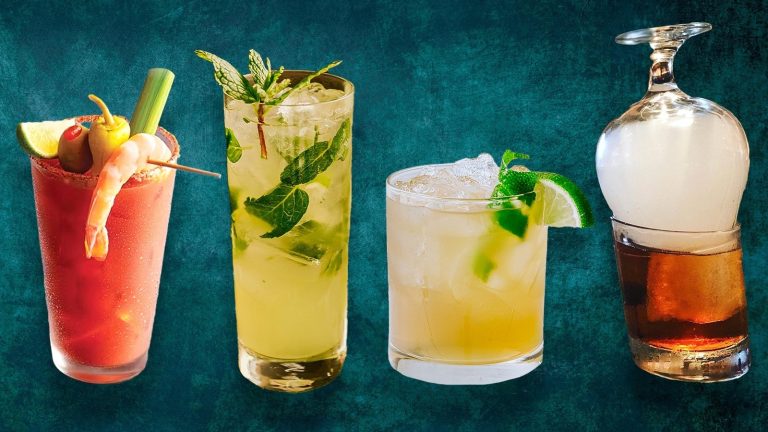Rising prices for groceries — and pretty much everything — seem to be a fact of life. We’ve all heard our grandparents complain about how ice cream used to cost a nickel in their day, compared to now, where a single scoop on a cone might set you back several dollars at least. This phenomenon is typically due to inflation, an economic trend where the price of goods rises over time. But inflation doesn’t always explain why certain goods become so much more expensive while the prices of others stay relatively unchanged or rise more gradually.
In fact, we’ve taken a look at the price differences between key grocery items in the 1950s and the present day and found that the rise has been due to a complex mix of economic, social, and environmental changes over the decades. Generally speaking, modern supply chains are more complex and vulnerable to disruption, as seen during the COVID-19 pandemic, which caused shortages and price spikes that we are still dealing with today. Global events such as the war in Ukraine and extreme weather events like flooding or drought have also impacted food production, reducing supply but not demand. And, yet amidst all this, food and beverage corporations have managed to increase their profits, which can only come from charging more to consumers. The result is that we are all paying a much bigger share of our income than our grandparents did, especially for the items on this list.
Eggs
The price of eggs has famously skyrocketed after the advent of the latest bout of bird flu, which began in 2022 and has been going strong ever since. This event has led to the culling of millions of infected chickens, which in turn caused a shortage of eggs and a spike in demand compared to existing stock. Prices have reached an average of $8 for a dozen eggs in 2025 compared to $2.25 in mid-2024. But this is not the first bird flu our country has ever seen, nor will it be the last, so it cannot by itself explain the difference in the price of eggs between the 1950s and now, especially since egg prices have started to decrease again as the bird flu subsides.
For instance, egg prices were already pretty high in the 1950s: The price of eggs was 52 cents a dozen, or upward of $5 per dozen when adjusted for inflation. That’s because war rationing had driven up the prices after WWII, and by the 1950s, those prices were only just starting to decline. Meanwhile, the price of feed for chickens has gone up over the years, as has the price of labor. But perhaps in a more sinister turn, there is reason to believe that producers are artificially keeping the prices high to earn higher profits. Although a full investigation has yet to be carried out, many lawmakers believe it is suspicious that the country’s biggest egg producer, Cal-Maine Foods, has seen a jump in profits of 82% late last year compared to the year before, suggesting egg prices are being manipulated.
Beef
Meat has always been a cut above other groceries when it comes to price. Even so, beef and other meats seem to cost more now than they did in the 1950s when compared to average incomes. At the time, beef ranged from 87 cents to 96 cents per pound, while it currently averages $8.25 per pound. While inflation can explain some of this, it doesn’t quite get to the meat of it. Certainly, the pandemic has played an important role: NerdWallet reports that food prices have increased by 31 percent compared to 2019, mostly because of increased operating costs and supply chain disruptions that occurred during the pandemic.
But there is more. Beef farming is not a very sustainable venture, as sad as that is to admit. As climatic conditions worsen across the board, the challenges and costs of producing beef have risen, leading many farmers to reduce their herd sizes, thereby reducing the supply of beef and driving up costs for consumers, even though our country still produces more beef than any other in the world. The number of cattle roaming our great plains is now the lowest it’s been since 1951, when the U.S. population was just nearly 150 million, compared to almost 344 million in 2025.
Bananas
Bananas are so ubiquitous across America that one could be forgiven for thinking they grow freely in our country. But alas, this is not so. Most bananas in the U.S. are imported from South and Central America — hotter climates that are currently suffering the effects of climate change more than ours, for the time being. How do we know this? That’s because there is such a thing as the World Banana Forum, where major players in the global banana supply chain meet to discuss best industry practices, and they recently agreed that climate change will soon drive up the cost of bananas even more so. There may soon come a day when bananas are not so everpresent on our grocery store shelves.
This is happening because while bananas like hot climates, they yield fewer and fewer bananas if their environment becomes too hot, decreasing the global supply. At the same time, warmer temperatures increase the risk the plants will contract diseases, like destructive fungi, that will stifle their growth. Even so, bananas have not significantly risen in price since the 1950s, when they cost 16 cents a pound — or $1.76 per pound when adjusted for inflation. At the time, bananas were rarer and considered luxury items, but after U.S. banana producers teamed up with authoritarian governments in the global south, prices were driven down, leading to a cost of about 63 cents per pound in 2025.
Milk
The price of milk has increased since the 1950s, though not as much as some other foods. At the start of that decade, the household staple cost an average of 83 cents per gallon before rising to 93 cents per gallon in 1955, when milk delivery became a more streamlined process through the use of paper milk cartons over glass bottles. Although this helped stave off further price hikes unrelated to inflation, milk still somehow got to an average of more than $4 per gallon in 2025.
This has been due to a number of factors, including the increasing cost of feed, energy, and labor. In particular, dairy farmers have had a tough time hiring labor, which has interfered with getting the milk to market. Meanwhile, cow herds are shrinking, and dairy production is tightening, compounding the price rises.
Sugar
The American diet would be very different without the copious use of sugar. Maybe it would be healthier; maybe it would be sadder, but the fact remains that we rely very much on this commodity and probably always will. This makes things difficult whenever the price of sugar goes up, which it periodically does. Indeed, while the U.S. produces some sugar locally, it also imports much of it from developing countries where political unrest can affect supplies and, therefore, prices. Indeed, most of the world’s sugar comes from Brazil and other South or Central American countries.
For instance, after the Cuban Revolution of 1959, the U.S. banned imports of sugar from that country, cutting off its most significant source of sugar. At the same time, a global production shortfall led to a spike in sugar prices everywhere, which seemed to suit sugar producers just fine, as they took advantage of the situation to further restrict the sugar supply and keep those prices high after those tumultuous events of the 1950s. Since then, the price of sugar has seen peaks and troughs, but overall, it is kept high by U.S. trade agreements that have restrictions on sugar imports and domestic production, keeping prices artificially high at just over $1 per pound compared to 48 cents per pound in the 1950s.
Coffee
Many people rely on coffee to help wake them up in the morning and set them up for a more productive day. Beyond that, coffee is a downright addictive substance that many people find hard to kick or even cut back on. So when it becomes clear that high coffee prices are here to stay, at least for a while, panic starts to set in. Indeed, early this year, the wholesale cost of arabica beans rose to more than $4 per pound, about double what it was a year ago, and people are not happy when they get to the checkout counter at the grocery store.
You may have heard that recently imposed tariffs on imports from certain countries will negatively affect the price of coffee. But this event is too recent and unpredictable to explain why coffee prices have been so high this year. What is more likely is that excessive rains and long droughts in Brazil and Vietnam, huge coffee exporters to the U.S., have lowered crop yields. At the same time, other populations have decided that they want to start drinking more coffee, leading to a rise in global demand. For instance, over the past 10 years, coffee consumption in China has risen by 150%. That said, the 1950s also saw a significant spike in coffee prices, which peaked at more than $8 per pound of unroasted coffee beans, which is even higher than the current average of more than $4 per pound. This was due to the cyclical nature of Brazilian coffee harvests.
Apples
If you live in a part of the country where apples grow plentiful, it may be hard to believe that the cost of apples could ever go up. Any New Englander, for instance, can tell you how every fall, the sides of the road are covered in rotting apples that fell from the apple trees present on almost every property in the countryside. They can tell you how these fallen apples attract bears and how many landowners would rather cut down their apple trees than deal with all that food waste. All this explains why the price of apples in the 1950s averaged 9 cents per pound — why apples now cost well over $1 per pound baffles the mind.
Yet, the price of apples has increased. Since 2020, prices are up 13%, while the cost to grow apples has risen by 30%, primarily due to the increasing cost of labor and transportation of goods. In fact, unlike many other goods, like sugar or eggs, the problem with apples is that there are just too many of them. Storing and transporting all these fruits becomes problematic, causing apple growers to lose money and pass on that loss to consumers. One reason growers have too many apples is that they have lost access to major export markets like India, which imposed retaliatory tariffs on goods like apples in response to U.S. tariffs on steel.
Butter
Butter makes every meal taste better, which is why it’s especially tragic when the price of butter soars. However, this has been happening over the past year due to a global milk shortage. While butter cost about $2 per pound on average prior to 2021, it has now risen to about $3, which is a hike of about 15% —that’s a lot when you’re a croissant lover and have no intention of ever using margarine.
This shortage has been caused in part by diseases affecting cows in Europe, a high demand for butter across the globe, and an increase in the cost of feed. That said, these are cyclical patterns that come and go, and as it happens, when adjusted for inflation, the price of butter these days is actually much lower than it was in the 1950s. At the time, butter sold for about 73 cents per pound, but that was more than $8 per pound when factoring in inflation.
Pork
Pork is having a moment. It seems like the whole world has finally woken up and smelled the bacon because it appears that every country these days wants a piece of that pork pie. In other words, the demand for pork has skyrocketed while supplies have remained more or less the same, which has caused the price of pork to go up to $3.7 per pound, while bacon alone rose to $7.6 per pound since the 1950s when pork and bacon were respectively 61 cents per pound and 59 cents. China, in particular, has upped its consumption of pork, though the timing has been unlucky since this happened right around the time a swine flu epidemic attacked its pork production, causing it to have to import pork from our neck of the woods.
Meanwhile, a new animal welfare law in California has increased costs for pork producers, at least temporarily, as many of them were required to make changes to their production procedures to comply with the new law, such as expanding their facilities to give their pigs more space to live a happier life, short as it may be. As producers adapt, delays and the production of pork products have followed suit, further restricting the global pork supply.
Rice
Rice is one of the most common staples across the world and is especially widely consumed throughout Africa and Asia. But even here in the U.S., rice is often used. You will see it as a side in many Asian restaurants, but also in Italian restaurants in dishes like risotto or arancini. Rice flour is also a common ingredient in gluten-free flour blends — in short, everywhere you look, there is rice.
This means that a rise in the price of rice can easily lead to a rise in the price of dinner in general. Indeed, this is what has been happening steadily — not just since the 1950s, but from 2023 onward in particular — for a variety of reasons. First, droughts and floods in rice-producing areas have led to a shortage of the product, but, perhaps more importantly, the policies of some countries have led to prices remaining artificially high, currently landing at about $1 per pound compared to 16 cents per pound in 1950. For instance, after Russia invaded Ukraine, access to affordable fertilizer became a problem for many grain growers, including rice producers. As if that weren’t enough, India, one of the world’s biggest exporters of rice, imposed an export ban on non-basmati rice to keep for its own citizens, shorting the market by about 10 million tons of rice it normally would have seen flow freely across borders. While that is all very well and good for the Indians, and rightly so, the rest of us will have to fork over more than usual for rice, at least for the time being.
Potato chips
While potatoes remain relatively accessible across the land, there is another story unfolding around one of their most popular derivatives: the all-American potato chip. Indeed, the U.S. Bureau of Labor Statistics reports that potato chips are now 50% more expensive than they were 10 years ago, and certainly since the 1950s, when a bag of potatoes sold for only 71 cents per 15-pound bag compared to 2025 when just one pound of potatoes costs about 96 cents. This is happening because of a shortage of potatoes due to climate change, which is affecting some of the country’s main potato-growing areas, such as Idaho and Pennsylvania, where potato crops are suffering from the effects of rising soil temperatures.
One might think that this would affect the price of potatoes overall, and to some extent, it has. But potato chips are even more heavily impacted because it takes a lot of potatoes to make a single bag of chips. After all, chips are basically dried-out and shriveled-up potatoes, as appetizing as that sounds, which is also why you can’t eat just one (while you literally can and probably do eat just one potato).
Cereal
Shrinkflation is a catchy term, but it’s also a very real phenomenon that describes a practice where some food manufacturers decided, without really telling anyone, that they would charge the same amount for a product but provide less of it, leading people to get less bang for their buck. Shrinkflation has affected many groceries, especially cereals, where it can be harder to gauge how much product is in the box unless you’re paying close attention to the grams noted on the package or the price per gram.
The worst part of shrinkflation, though, is that investigations have found that some cereal companies not only downsized their products, but they did so while also increasing their prices. People unaware of the phenomenon might have noticed, with some degree of confusion, that they are now hungrier at breakfast or that some mysterious house elf seems to be siphoning away their cereal every morning. Those who do know what the cereal companies are up to can be forgiven for being very much annoyed by the practice. Yet this is not the first time in history that cereal has stood out for its priciness. Between 1950 and 1964, the price of cereal rose by 39% compared to 20% for other food items, likely because of its increase in popularity as it became known as a sugary treat rather than a health food. For instance, an 8-ounce box of cornflakes in 1950 cost 16 cents, while a 12-ounce box today is at least $6.





